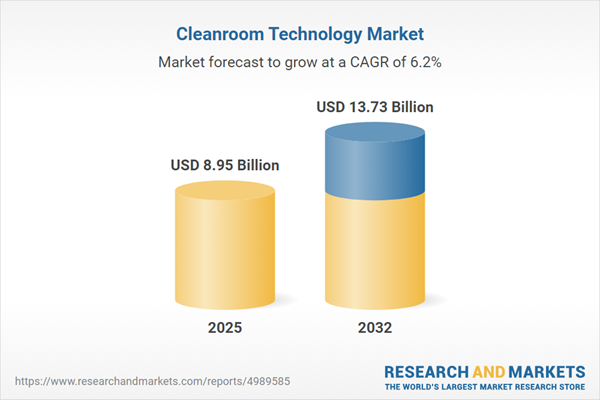Speak directly to the analyst to clarify any post sales queries you may have.
Senior executives seeking clarity in the cleanroom technology market face shifting regulatory expectations, evolving operational standards, and a critical need for reliable, sustainable solutions. This report equips leadership with actionable insight to support compliance, operational efficiency, and strategic growth throughout the cleanroom sector.
Cleanroom Technology Market Snapshot
The cleanroom technology market is experiencing steady expansion, driven by increasing industry emphasis on advanced contamination control and the implementation of flexible facility infrastructure. Organizations in pharmaceuticals, biotechnology, and microelectronics continue to adopt optimized processes for improved quality and regulatory alignment. Expanded use of digital monitoring and modular construction is helping to reshape facility operations, while attention to sustainable practices is rising. Varying regulatory demands across North America, Europe, Asia-Pacific, and developing markets contribute to diverse integration needs, causing businesses to adapt their cleanroom solutions to local requirements. As digital transformation accelerates, technology adoption and streamlined workflows offer organizations a foundation for improved competitiveness and compliance.
Scope & Segmentation in the Cleanroom Technology Market
- Contamination Control Consumables: Disinfectants, specialty wipes, and protective apparel are essential for ensuring hygiene adherence and regulatory compliance in research and manufacturing environments.
- Cleanroom Equipment: Air diffusers, HEPA filters, modern HVAC units, and laminar flow systems are vital to maintaining required air quality and stability within controlled environments.
- Construction Types: Hard-wall, modular, soft-wall, and mobile setups allow organizations to meet both permanent infrastructure and temporary project demands.
- Airflow Technologies: Unidirectional and non-unidirectional airflow systems help align cleanroom operations with targeted cleanliness classifications and risk profiles.
- ISO Cleanroom Classes: Use of ISO Classes 1 through 9 enables businesses to address a spectrum of contamination control needs across various processes.
- Sector Applications: Cleanroom technologies are deployed in areas such as assembly, packaging, process validation, quality verification, and R&D to reinforce compliance and efficiency standards.
- End-User Industries: Automotive, pharmaceuticals, biotechnology, microelectronics, and food and beverage industries all depend on customizable cleanroom solutions to meet operational and regulatory objectives.
- Regional Markets: The United States, China, India, and other major regions utilize cleanroom strategies that reflect distinct regulatory structures and local business priorities.
- Corporate Benchmarks: Leading sector standards are shaped by companies including DuPont de Nemours, Siemens AG, ABN Cleanroom Technology, Angstrom Technology, and Exyte GmbH, driving alignment around best practices and innovation in cleanroom operations.
Key Takeaways for Senior Decision-Makers
- Adopting modular and mobile cleanroom solutions enables agile project execution and improved adaptability, minimizing business disruption during process updates.
- Integrating IoT-enabled monitoring platforms strengthens process oversight and supports rapid detection of compliance issues, keeping operations aligned with evolving standards.
- Flexible cleanroom layouts allow organizations to control spending effectively and respond to technology updates and regulatory changes efficiently.
- Building robust supplier relationships helps companies address procurement risks, ensuring ongoing operational support in dynamic environments.
- Incorporating sustainable materials and refining core processes advances both regulatory compliance and long-term environmental commitments.
Tariff Impact and Strategic Sourcing
Changes in U.S. tariffs affecting cleanroom technology components require leadership to adjust sourcing approaches. Companies are responding by boosting domestic procurement, revising inventory management strategies, and renegotiating contracts with suppliers. These actions help protect operational continuity and reduce vulnerabilities associated with changing trade policies and regulations.
Methodology & Data Sources
This overview draws on comprehensive market analysis, executive interviews, and technical documentation assessment. Strategic recommendations are developed from best-practice SWOT and value chain reviews, ensuring that insights are actionable and grounded in current industry trends.
Why This Report Matters for Leaders in Cleanroom Technology
- Segment-focused intelligence supports alignment of executive-level strategies with the latest practices in cleanroom design and management.
- Action-oriented recommendations help organizations anticipate supply chain shifts, regulatory changes, and emerging market dynamics, reinforcing robust planning and response capabilities.
- Industry benchmarks offer a solid foundation for evidence-based decision-making and systematic compliance across all areas of operation.
Conclusion
This report provides senior leaders in cleanroom technology with critical analysis and guidance, empowering the adoption of agile, digitally enabled, and sustainable cleanroom strategies for ongoing regulatory and operational success.
Additional Product Information:
- Purchase of this report includes 1 year online access with quarterly updates.
- This report can be updated on request. Please contact our Customer Experience team using the Ask a Question widget on our website.
Table of Contents
3. Executive Summary
4. Market Overview
7. Cumulative Impact of Artificial Intelligence 2025
Companies Mentioned
The companies profiled in this Cleanroom Technology market report include:- DuPont de Nemours, Inc.
- Siemens AG
- ABN Cleanroom Technology NV
- Abtech Incorporated
- AIRTECH System Co., Ltd.
- Alpiq Group
- Angstrom Technology, Ltd. by Asgard Partners & Co.
- Ardmac Group Limited by Purever Industries
- Bouygues E&S InTec Schweiz AG
- Clean Air Products, Inc.
- Clean Rooms International Inc.
- COLANDIS GmbH
- Exyte GmbH by M+W Group GmbH
- Genano Ltd.
- Getinge AB
- Gilcrest Manufacturing Limited
- Guardtech Cleanrooms Ltd.
- Integrated Cleanroom Technologies Pvt. Ltd. by Takasago Thermal Engineering Group
- ITW Contamination Control BV
- KIMBERLY-CLARK CORPORATION
- Labconco Corporation
- Lennox Clean Air Technologies
- Nicos Group, Inc.
- Nortek Air Solutions, LLC
- OCTANORM-Vertriebs-GmbH
- Parteco S.r.l.
- Subzero Engineering, Inc.
- Taikisha Ltd.
- Terra Universal, Inc.
- Vertex Air Technologies Private Limited
Table Information
| Report Attribute | Details |
|---|---|
| No. of Pages | 190 |
| Published | November 2025 |
| Forecast Period | 2025 - 2032 |
| Estimated Market Value ( USD | $ 8.95 Billion |
| Forecasted Market Value ( USD | $ 13.73 Billion |
| Compound Annual Growth Rate | 6.2% |
| Regions Covered | Global |
| No. of Companies Mentioned | 31 |







